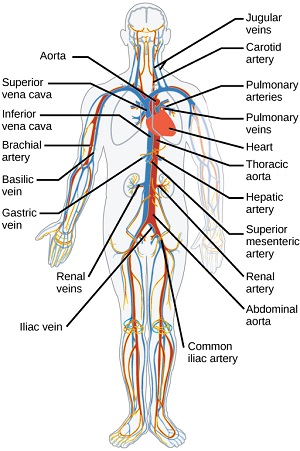Module 6: The Respiratory System and The Circulatory System
Section outline
-
 In this module, students will learn about the anatomy and physiology of the respiratory and circulatory systems. Differences and similarities will be discussed as these systems are explored in humans and in other organisms as well.
In this module, students will learn about the anatomy and physiology of the respiratory and circulatory systems. Differences and similarities will be discussed as these systems are explored in humans and in other organisms as well.The primary function of the respiratory system is to deliver oxygen to the cells of the body’s tissues and remove carbon dioxide, a cell waste product. The main structures of the human respiratory system are the nasal cavity, the trachea, and lungs.
The circulatory system is effectively a network of cylindrical vessels: the arteries, veins, and capillaries that emanate from a pump, the heart.
In all animals, except a few simple types, the circulatory system is used to transport nutrients and gases through the body. The circulatory system varies from simple systems in invertebrates to more complex systems in vertebrates.
Image from Biology 2e from OpenStax, licensed under Creative Commons Attribution License v4.0 with the image credit modification of work by Mariana Ruiz Villareal
Upon completion of this module, you will be able to:- Describe the passage of air from the outside environment to the lungs
- Explain how the lungs are protected from particulate matter
- Name and describe lung volumes and capacities
- Understand how gas pressure influences how gases move into and out of the body
- Describe how the structures of the lungs and thoracic cavity control the mechanics of breathing
- Explain the importance of compliance and resistance in the lungs
- Discuss problems that may arise due to a V/Q mismatch
- Describe how oxygen is bound to hemoglobin and transported to body tissues
- Explain how carbon dioxide is transported from body tissues to the lungs
- Describe an open and closed circulatory system
- Describe interstitial fluid and hemolymph
- Compare and contrast the organization and evolution of the vertebrate circulatory system
- List the basic components of the blood
- Compare red and white blood cells
- Describe blood plasma and serum
- Describe the structure of the heart and explain how cardiac muscle is different from other muscles
- Describe the cardiac cycle
- Explain the structure of arteries, veins, and capillaries, and how blood flows through the body
- Describe the system of blood flow through the body
- Describe how blood pressure is regulated
Upon completion of the laboratory activity in this module, you will be able to:
- State the parts of the cardiovascular and respiratory systems and give the functions of each part.
- Identify the parts of the cardiovascular and respiratory systems on the human torso model and other models.
- Explain how the respiratory and cardiovascular systems are interrelated.
- Describe the path of the blood through the heart
- Test the effects of various factors on heart rate and breathing rates
- Measure various respiratory volumes using a spirometer.
- Define the laboratory activity terms provided.
To achieve these objectives:
- Read the Module 6 Introduction
- Read and view the materials in the Module 6 Pressbooks book
- Read Chapter 18 and Chapter 19 in Module 6 Pressbooks book
- Complete the Module Assignment
- Complete the Module Discussion
- Complete the Module 6 Laboratory Activity: Cardiovascular and Respiratory Systems Lab
- Complete and submit a written laboratory report using the format provided for the Activity Investigation
Module Pressbooks Resources and Activities
You will find the following resources and activities in this module at the Pressbooks website. Click on the links below to access or complete each item.
Background Colour
Font Face
Font Kerning
Font Size
Image Visibility
Letter Spacing
Line Height
Link Highlight
Text Colour
